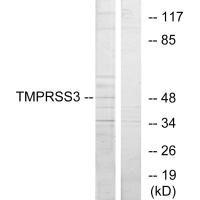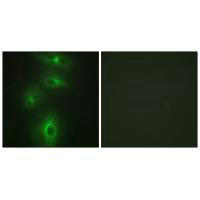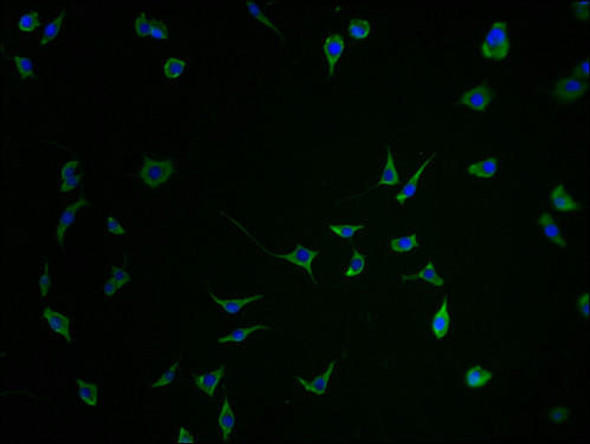Description
TMPRSS3 Antibody (PACO23236)
The TMPRSS3 Polyclonal Antibody (PACO23236) is a valuable tool for researchers studying TMPRSS3, a transmembrane serine protease involved in various physiological processes. This antibody, produced in rabbits, exhibits high specificity and sensitivity towards human samples, making it suitable for use in Western blot applications. By targeting the TMPRSS3 protein, researchers can effectively detect and analyze its expression in different cell types, providing insights into its function in various biological pathways.TMPRSS3 is known for its role in proteolytic processing and activation of proteins involved in cell signaling, metabolism, and tissue homeostasis.
Dysregulation of TMPRSS3 has been implicated in diseases such as cancer, infectious diseases, and neurodegenerative disorders, underscoring the importance of studying its function and regulation. The TMPRSS3 Polyclonal Antibody is a valuable asset for researchers aiming to unravel the complexity of TMPRSS3-mediated processes and develop targeted therapeutic strategies for related diseases.
| Antibody Name: | TMPRSS3 Antibody (PACO23236) |
| Antibody SKU: | PACO23236 |
| Size: | 100ul |
| Host Species: | Rabbit |
| Tested Applications: | ELISA, WB, IF |
| Recommended Dilutions: | ELISA:1:2000-1:10000, WB:1:500-1:3000, IF:1:100-1:500 |
| Species Reactivity: | Human, Mouse |
| Immunogen: | Synthesized peptide derived from C-terminal of human TMPRSS3. |
| Form: | Liquid |
| Storage Buffer: | Rabbit IgG in phosphate buffered saline (without Mg2+ and Ca2+), pH 7.4, 150mM NaCl, 0.02% sodium azide and 50% glycerol. |
| Purification Method: | The antibody was affinity-purified from rabbit antiserum by affinity-chromatography using epitope-specific immunogen. |
| Clonality: | Polyclonal |
| Isotype: | IgG |
| Conjugate: | Non-conjugated |
 | Western blot analysis of extracts from HUVEC cells, using TMPRSS3 antibody. |
 | Immunofluorescence analysis of HeLa cells, using TMPRSS3 antibody. |
| Background: | Probable serine protease that play a role in hearing. Acts as a permissive factor for cochlear hair cells survival and activation at the onset of hearing and is required for saccular hair cell survival By similarity. Activates ENaC (in vitro). |
| Synonyms: | Transmembrane protease; serine 3; EC 3.4.21.-; Serine protease TADG-12; Tumor-associated differentially-expressed gene 12 protein |
| UniProt Protein Function: | TMPRSS3: Probable serine protease that play a role in hearing. Acts as a permissive factor for cochlear hair cells survival and activation at the onset of hearing and is required for saccular hair cell survival. Activates ENaC (in vitro). Defects in TMPRSS3 are the cause of deafness autosomal recessive type 8 (DFNB8). DFNA8 is a form of sensorineural hearing loss. Sensorineural deafness results from damage to the neural receptors of the inner ear, the nerve pathways to the brain, or the area of the brain that receives sound information. Defects in TMPRSS3 are the cause of deafness autosomal recessive type 10 (DFNB10). Belongs to the peptidase S1 family. 5 isoforms of the human protein are produced by alternative splicing. |
| UniProt Protein Details: | Protein type:Protease; Membrane protein, integral; Endoplasmic reticulum; EC 3.4.21.- Chromosomal Location of Human Ortholog: 21q22.3 Cellular Component: endoplasmic reticulum; endoplasmic reticulum membrane Molecular Function:sodium channel regulator activity Biological Process: cellular sodium ion homeostasis Disease: Deafness, Autosomal Recessive 8 |
| NCBI Summary: | This gene encodes a protein that belongs to the serine protease family. The encoded protein contains a serine protease domain, a transmembrane domain, an LDL receptor-like domain, and a scavenger receptor cysteine-rich domain. Serine proteases are known to be involved in a variety of biological processes, whose malfunction often leads to human diseases and disorders. This gene was identified by its association with both congenital and childhood onset autosomal recessive deafness. This gene is expressed in fetal cochlea and many other tissues, and is thought to be involved in the development and maintenance of the inner ear or the contents of the perilymph and endolymph. This gene was also identified as a tumor-associated gene that is overexpressed in ovarian tumors. Alternatively spliced transcript variants have been described. [provided by RefSeq, Jan 2012] |
| UniProt Code: | P57727 |
| NCBI GenInfo Identifier: | 13124582 |
| NCBI Gene ID: | 64699 |
| NCBI Accession: | P57727.2 |
| UniProt Secondary Accession: | P57727,Q5USC7, Q6ZMC3, D3DSJ6, |
| UniProt Related Accession: | P57727 |
| Molecular Weight: | 58,324 Da |
| NCBI Full Name: | Transmembrane protease serine 3 |
| NCBI Synonym Full Names: | transmembrane protease, serine 3 |
| NCBI Official Symbol: | TMPRSS3 |
| NCBI Official Synonym Symbols: | DFNB8; DFNB10; ECHOS1; TADG12 |
| NCBI Protein Information: | transmembrane protease serine 3 |
| UniProt Protein Name: | Transmembrane protease serine 3 |
| UniProt Synonym Protein Names: | Serine protease TADG-12; Tumor-associated differentially-expressed gene 12 protein |
| Protein Family: | Transmembrane protease serine |
| UniProt Gene Name: | TMPRSS3 |
| UniProt Entry Name: | TMPS3_HUMAN |
| Antibodies | ELISA Kits |
| TMPRSS3 Antibody (PACO01637) | TMPRSS3 Colorimetric Cell-Based ELISA |
| Secondary Antibody |
| Anti-HRP Goat Anti-Rabbit IgG (H+L) Antibody (CABS014) |
| Recommended Products |
| Anti-FITC Goat Anti-Rabbit IgG (H+L) Antibody (CABS011) |
| Anti-HRP-conjugated Beta Actin Antibody (CABC028) |













